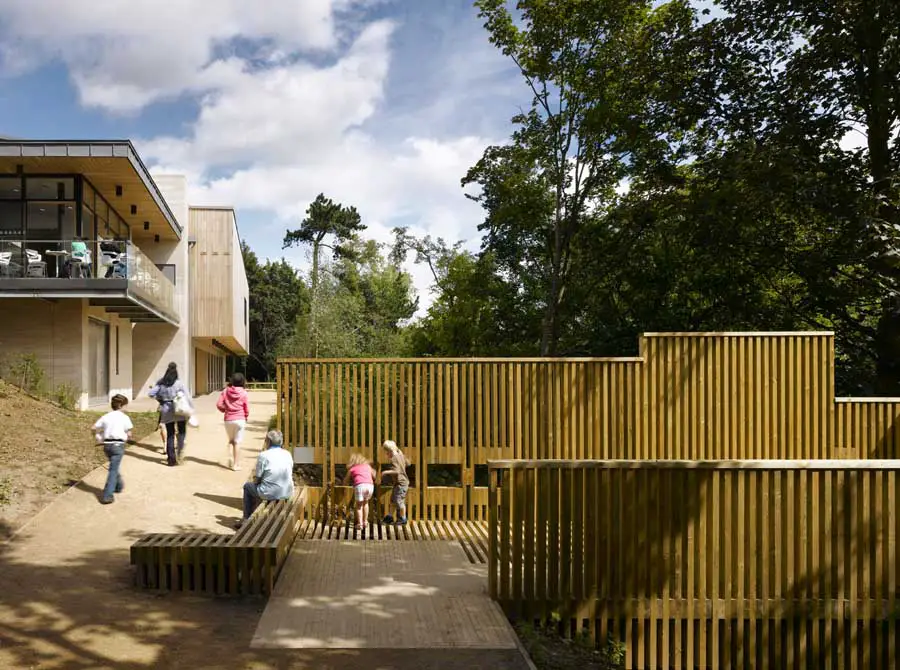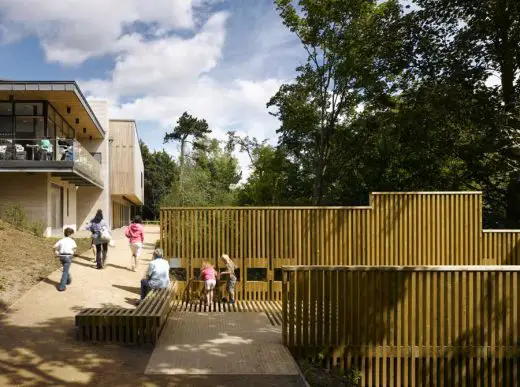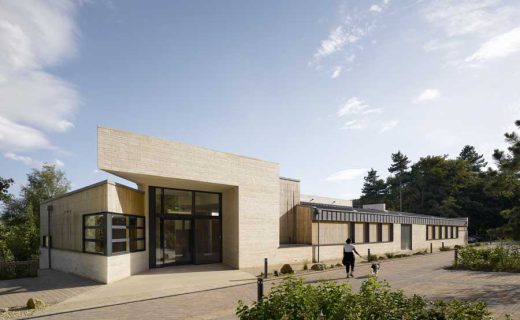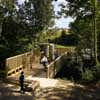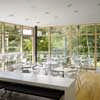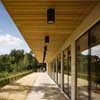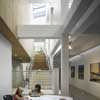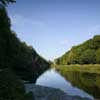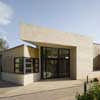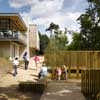Creswell Crags Ice Age Museum, Nottinghamshire Architecture, Worksop Building, OMI Architects
Creswell Crags – Ice Age Museum, near Worksop
Creswell Crags Museum, central England design by OMI Architects, UK
19 May 2011
OMI Architects Ice Age Museum Wins RIBA Award
OMI ARCHITECTS of Manchester have received an RIBA Award for Design Excellence for its stunning Museum at Creswell Crags on the Derbyshire/ Nottingham border near Worksop.
Creswell Crags Museum
Creswell Crags is one of Britain’s most important archaeological and geological sites and is currently shortlisted for World Heritage Status. A dramatic magnesium limestone gorge, fractured by a series of fissures and deep-cut caves the crags has provided evidence of human and animal activity dating back more than 50,000 years.
Archaeological finds have included bones of woolly mammoth, hippopotamus, bison and rhinoceros as well as delicately carved tools left behind by Ice Age hunters. Creswell Crags hit the headlines in April 2003 with the discovery of the Ice Age Cave Art that was billed as one of the most important prehistoric finds in the last decade. It is Britain’s earliest cave art – 13,000 years old, with figures of birds, deer, bison and horse.
The project involved the sensitive design of a new museum and education centre on this precious site, to interpret the morphology of Creswell Crags and its rich collection of artefacts that have been brought back home from the likes of the British Museum.
The new building acts as a gateway to the crags and the fragmented form of the new structure defines a descending sequence of movement that arrives at the foot of the gorge. Locally sourced magnesium limestone is used throughout to connect the building with the indigenous geology. The raw oak boarding is aging nicely and is a response to the woodland setting.
The building is intentionally discrete and modest, playing a supporting role to the main attraction – the gorge. It guides the visitor on their journey and subtly instils a real sense of drama and anticipation.
The building’s eco credentials were recognised in 2010 with an RIBA Sustainability Award.
David McCall, OMI Architects said: “ Creswell Crags is one of the most important museum sites we have worked on and is an important progression of our work in this sector. Our previous work has included the National Football Museum in Preston, the People’s History Museum in Manchester and the Chinese Arts Centre in Manchester. It is one of the most sensitive sites in the UK, possibly up there with Stonehenge. The need for the building to inform visitors – but not detract from the setting was fundamental and demanded the sort of balanced approach we are known for.
The site has a tranquil timeless quality that quickly transports the visitor back in time. Great care has been taken to ensure the site gets the quality of building it deserves. We went through a rigorous site selection process to ensure there was no detrimental impact upon the setting. Our aim was to create a contemporary museum building that visitors can move through freely and take in interpretive information in a relaxed and informal manner before they venture outside to visit the caves.
The museum is in effect a gatehouse to the Crags, directing visitors towards the site whilst offering important interpretation of what they are going to see or have just seen. The principal feature within the site is the Crags themselves. The new building aims to be a complimentary backdrop. A high quality structure that is a delight to use and move through, but, one that does not overwhelm its setting.
Creswell Crags Museum is the culmination of nearly ten years of OMI involvement with the site providing a range of architectural services from early feasibility work through to the design and construction of the new museum and footbridge. The project reflects OMI Architect’s interest in sculptural forms, creating beauty and delight in our buildings whilst responding to the human, social, environmental and spiritual values that inform them to give the architecture depth and relevance.”
OMI Architects
OMI Architects is based in Manchester and was established in the early 1990’s by current directors Philip O’Dwyer and David McCall. The practice works in the fields of museums and galleries, urban design, housing, offices, education, churches and community buildings. The firm’s commitment to thoroughness and innovation has resulted in a distinctive body of work that has attracted critical acclaim and a series of national design awards.
OMI’s conversion of the Artinstall’s Chapel in Manchester is also shortlisted for an RIBA Award this year.
The Site
Creswell Crags is a stunning, naturally formed, 500 metre long gorge cut into the magnesium limestone on the Nottingham/Derbyshire border, 10 miles east of Chesterfield. The site is a Scheduled Ancient Monument, a Site of Special Scientific Interest, a Conservation Area, a Site of Importance for Nature Conservation and part of a Grade II listed park associated with Welbeck Abbey.
A series of caves formed within the magnesium limestone cliffs that line the gorge have provided a vast array of archaeological discoveries. The site hit the headlines in April 2003 with the discovery of the Ice Age Cave Art that was billed as one of the most important prehistoric finds in the last decade. It is Britain’s earliest cave art – 13,000 years old, with figures of birds, deer, bison and horse. Archaeological finds dating back between 10,000 and 50,000 years ago have also been discovered, including bones of woolly mammoth, hippopotamus and rhinoceros.
The caves were inhabited intermittently by hyena packs that dragged their prey back into the protection of the caves. Excavations have also unearthed some exquisite examples of crafted flint and bone tools proving that Ice Age hunters visited the site to hunt reindeer and horse. The most famous is an 8cm long fragment of bone with an etched outline of a horse thought to be approximately 12,500 years old which is currently on loan to the museum from the British Museum.
The new building incorporates state-of-the-art exhibition areas, a research laboratory and library, collection storage facilities, a suite of rooms for education groups, talks and conferences a shop, café and administration offices. The British Museum is one of several museums that have already agreed to loan back artefacts and support special exhibitions as part of their UK partnership scheme. Funding for the scheme included a Heritage Lottery Fund award of £4.23m, a European Regional Development Fund award of £750,000 and a further £800,000 from the East Midlands Development Agency (emda).
Building Description
The new building is approximately 1300m2 in area and is roughly five times larger than the previous visitor centre that was demolished as part of the redevelopment. The building is located within steeply sloping woodland overlooking the gorge.
The basic form is that of two long low linear blocks running parallel to the contours of the site over two storeys – the north side single storey and the south face two storeys. The building acts as an intentional visual barrier between the visitor car park and the gorge to ensure views of the site are restricted until an appropriate stage in the visitor sequence. Only once the visitor starts to move through the building will glimpses of the site unfold.
Two magnesium limestone ashlar stone spine walls split the building into two parallel blocks and define the circulation route through the building. The walls rise in height above the adjacent primary blocks to enhance the legibility of the circulation route to the Crags.
On the north side of the building a single storey timber clad structure houses the back-of-house activities such as the offices, storage and maintenance areas. The ashlar stone walls puncture this element and form a full height “cave” entrance clearly visible from the car park.
The southern portion of the building opens up to the stunning views and sunny aspect. A two-storey timber clad block with a stone base hugs the circulation spine. At high level the timber clad exhibition space overhangs the solid masonry base containing the education area below. At the western end of the building a simple glazed form cantilevers out to form the second ‘prow’ of the building containing the coffee shop and providing the visitor with views towards the Crags. Housed in the low-level masonry base, the education spaces are provided an immediate relationship to the site for kids to wander back and forth to the site.
Sustainable measures include locally sourced building materials such as magnesium limestone and English oak. The building is heated using ground source heat pumps and rainwater is harvested for water recycling. The oak cladding incorporates bat nests for the 100’s of bats temporarily displaced by the demolition of the former visitor centre.
The Museum Makers programme also contributed to the project. Artist Myfanwy Johns designed illuminated glass panels that were incorporated into the museums reception area. Robert Frith designed an undulating perforated honeycomb wall to the foyer area.
The building is separated from the site by a stream that marks the Derbyshire/Nottinghamshire border. To connect the building to the site a new footbridge was built. Positioned within sensitive flora and fauna habitat the Bridge of Discovery invites visitors to gain glimpses of the riverbank wildlife.
Sir David Attenborough and museum patron Professor David Bellamy opened the museum in 2009.
Creswell Crags Ice Age Museum images / information from OMI Architects
Location: Creswell Crags, near Worksop, central England, UK
Nottinghamshire Architecture – Selection
Centre for Contemporary Arts Nottingham – Lace Market
Caruso St John
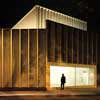
image : Hélène Binet
Nottingham Arts Building
Jubilee Campus Expansion, University of Nottingham
make Architects
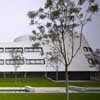
photograph : Zander Olsen
University of Nottingham Jubilee Campus
Maggies Nottingham
CZWG

image © Maggie’s Centres
Maggies Nottingham
MediPark for Nottingham
Studio Egret West
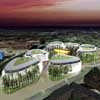
image from architect
MediPark Nottingham
New Art Exchange, Nottingham
HawkinsBrown
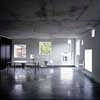
image : Helene Binet
New Art Exchange
Old Market Square, Nottingham
Gustafson Porter
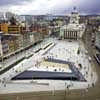
photo: Dom Henry www.domhenry.com
Nottingham square
County Architecture adjacent to Nottinghamshire
Comments / photos for the Creswell Crags Ice Age Museum design by OMI Architects page welcome

